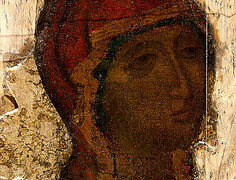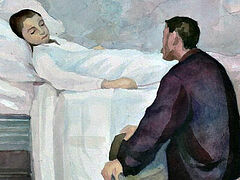 Icon at the Holy Dormition Church of the Knyaginin (Princess’) Convent, 2008 In the early 2000s I once again paid a visit to Bogolyubovo Convent.1 Where in the twelfth century the horses of the holy Grand Prince Andrei Bogolyubsky, carrying the icon of the Most Holy Theotokos from Vyshgorod, stopped rooted to the spot, today there is a magnificent convent.
Icon at the Holy Dormition Church of the Knyaginin (Princess’) Convent, 2008 In the early 2000s I once again paid a visit to Bogolyubovo Convent.1 Where in the twelfth century the horses of the holy Grand Prince Andrei Bogolyubsky, carrying the icon of the Most Holy Theotokos from Vyshgorod, stopped rooted to the spot, today there is a magnificent convent.
Revived through the labors of Schema-Archimandrite Peter (Kucher; 1926–2020), it, along with the Dormition Cathedral and the Church of the Protection of the Mother of God on the Nerl River, is today the calling card of the Vladimir region. And pilgrims arriving at this gem of the “Golden Ring” of Russia, do not miss the opportunity to venerate the huge full-length Bogolyubovo Icon of the Theotokos.
True, it was kept here until 1922. Since 1991, when the convent was returned to the faithful, a copy has been kept here.
“But where is the original icon?” I thought every time I visited the convent.
My long-standing student habit of always getting to the roots of things helped me. Gradually I learned that the original icon is located very close—at the Holy Dormition Knyaginin (“Princess’”) Convent in the city of Vladimir.
***
So, here I am.
It is a little younger than Bogolyubovo Convent (by about 100 years). Before the Second World War the Soviet authorities opened a local “Museum of Atheism and Religion” within its walls. They brought venerated icons, particles of relics, and church utensils here from all over the region. The Bogolyubovo Icon was placed here as well.
It so happened that initially the church in the convent was also used as a burial vault. Here, in the left wing, Nun Martha (born Maria Shvarnovna, venerated as a local saint in Vladimir), the wife of Grand Prince Vsevolod the “Big Nest” of Vladimir (1176–1212), and Nun Bassa (born Alexandra Bryachislavna of Polotsk, venerated as a local saint of Vladimir), the wife of the holy Grand Prince Alexander Nevsky, found their resting place.
However, God is not mocked (Gal. 6:7). By His special Providence, the staff of the Museum of Atheism turned out to be believers and church people… Therefore, after a working day, behind closed doors, they almost daily read Akathists and prayers in front of the Orthodox shrines. Perhaps it was largely thanks to their prayers that not a single enemy bomb fell on the city of Vladimir during the Second World War…
***
Having crossed the threshold of the convent’s Holy Dormition Church, you seem to be transported back to the past. Outside, everyday life is frenzied, with the hustle and bustle of a big city. The sun is shining brightly, but silence and a majestic peace reign here. The dark, ancient walls rise upwards, with narrow windows in semidarkness and penetrated with a prayerful atmosphere.
At the time, in 2003, there were two main relics here: a small reliquary with a particle of the relics of Martyr Abraham of Bolgar (†1229; feast: April 1/14) and the original wonderworking Bogolyubovo Icon.
The icon was placed in the row of the iconostasis, on its left side, but in order to avoid the harmful effects of dampness it was “packed” into an air-tight case covered with bulletproof glass. The successful lighting of the icon and beautiful fresh flowers finished the job. As a result, the Bogolyubovo icon looked wonderful!
Surprisingly, when approaching it, my legs would almost give way. The awareness of its greatness and historical significance made me want to kneel down right away.
“Oh my God! The twelfth century!” I thought with awe then. “What a unique opportunity to address the Mother of God Herself, directly!”
My heart said to me: “She is standing invisibly beside you—ask, repent, implore and thank! She is listening to you attentively!”
***
During the day it was very good to pray in the empty, semi-dark church. I was on my knees in front of the icon for a long time, and no one bothered me. I poured out my soul to the Mother of God and I felt better. Carefully, with trepidation, I venerated the edge of Her garments and crawled away quietly.
“You know, I often carry out my obediences here at the church,” suddenly a churchworker, a middle-aged nun, said to me in a low voice. “And recently we had an incident here that simply staggered us all.”
The Orthodox journalist immediately awakened in me, and I asked her:
“That’s very interesting. Tell me, please.”
***
“One afternoon on a weekday I was standing at a candlestand in the center of the church and rearranging candles on it,” the nun began her story. “Occasional visitors would come and go. And then I noticed a woman. After standing in front of the Bogolyubovo icon for a while and, apparently, having prayed, she stepped to full height on the rug in front of the icon and moved straight towards the image.
“What happened next will probably remain in my memory for the rest of my life,” the nun went on. “Coming close to the icon, the woman stretched out her neck with the obvious intention of kissing the Virgin Mary... right on the mouth. In an instant she would have done it, but at that moment an invisible power just threw her away from the holy icon!
“She flew several yards into the air, towards this column, and collapsed right onto the stone floor! Only her shoes flashed in the air! I wonder how she survived…” the nun told me.
***
That’s the story.
Then the holy icon was transferred back to the Vladimir Museum, access to it was banned, and it fell into the full possession of restorers.
Years have passed, and now I have found out that since recently it became possible to pray freely in front of the Bogolyubovo Icon of the Mother of God again—now at the “Chambers” Museum Center of the Vladimir and Suzdal Museum-Reserve.
And let this incident serve as edification story for some of us.





